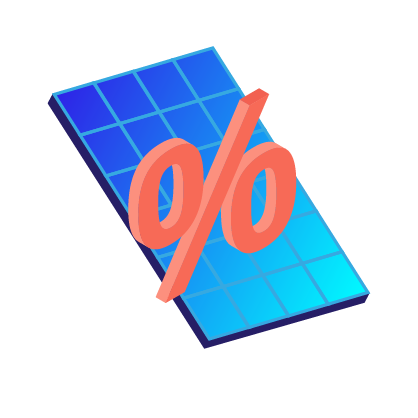See how much solar panels cost in your area

Please enter a valid zip code.
Zero Upfront Cost
Best Price Guaranteed
![]()
![]()
Solar Learning Center > Solar Panels for Home > Key Solar Terms
Key Solar Terms
Going solar isn’t something people do everyday and unless you have an electrical engineering degree, it’s likely you’ll bump into some new phrases and terms.
This guide defines key solar terms to help you make educated decisions while going solar.
Dig in!
Key Solar Panel System Terms
Current
A flow of an electrical charge carried through wires. Read more under AC and DC.
Alternating Current (AC)
This refers to the current of an electrical device. AC is what U.S. households are accustomed to. All appliances, lights and other home electrical devices run off AC. Our power lines carry AC as well. However, when solar panels create energy, they create it in DC, creating a need for an inverter to convert the energy to AC.
Direct Current (DC)
This refers to the current of an electrical device. DC, or Direct Current, is produced by solar panels and batteries. DC can be converted to AC through an inverter, which is how we’re able to use the electricity produced from solar panels in our houses. When we refer to the size (watts or kW) of solar, we’re referencing DC output. Once the conversion to AC has been made, the AC watts will typically be 15%-20% less than the rated DC watts.
Angle of Incidence
The angle a ray of sun makes with a line perpendicular to a solar panel. For example, if a panel had a 0-degree angle of incidence, it would be directly above the panel. At sunrise or sunset, it would be close to 90 degrees. The closer to 0 degrees, the more direct the sunlight, and thus the more energy a panel would produce.
Carbon Dioxide (CO2)
This is produced from fossil fuels when they are burned to produce electricity. Carbon is commonly known as the greenhouse gas that is most severely affecting global climate change. With solar energy, your personal carbon production will be far less than continuing to use power from the utility grid.
Community Solar
This is when there is a shared solar system that multiple members of a community invest in. When a utility customer cannot put solar on their own residence, they may opt into community solar. How community solar works with utility systems is still being figured out in some areas, but in other areas, community solar is up and running. By opting into a community solar program, it will likely save the members money on electric bills and offset carbon use for the community.
Diffuse Insolation
This refers to sunlight received indirectly due to clouds, haze, fog, or other atmospheric obstructions. This sunlight will not produce as much energy as direct insolation, but it can still produce energy. Monocrystalline cells are best suited to maximize production from diffuse insolation.
Diode
This allows electricity to pass in one direction but not the other. This is used on a solar system to ensure energy is not sent back to panels when they are not producing electricity.
Direct Insolation
This is how much direct sunlight hits an area of Earth. This is determined by taking the irradiance above the atmosphere and subtracting atmospheric losses.
Electric Current
This is the flow of an electric charge. This charge is created by electrons flowing through a wire.
Energy Audit
These are performed on buildings to analyze the energy input into them. They are done both at the time of construction to pass municipal mandates and at a time when the building owner is looking to conserve energy. Homeowners often do this to better understand how much energy they use and what upgrades they would be able to do to use less energy and save money.
Fossil Fuels
Coal, oil, and natural gas are the three major forms of fossil fuels we use today to create energy. These are natural resources that formed over millions of years. When these are burned to create power, they put off extensive amounts of pollutants into our atmosphere, which has been proven to be a root cause of climate change. Solar energy is produced directly from the sun without having to burn fossil fuels, therefore combating global warming.
Full Sun
The amount of sunlight hitting a surface at midday. This signifies the maximum output of a system.
Ground or Grounding
A ground is where the voltage is zero. Grounding is something done to all solar systems by attaching any metal features of a solar system to a ground. This protects against unintentional shocks or potential fires by “grounding” the voltage. Basically, it removes any potential voltage from areas where it is not intended to be.
GW or Gigawatt
A unit of power equal to 1 billion watts, 1 million kilowatts, or 1 thousand megawatts.
Incident Light
Sunlight that shines on the surface of a solar module.
Insolation
Solar power density on a surface over a period of time. This measurement is in Watts per square meter.
Irradiance
The total solar radiation that strikes a surface, including direct, diffuse, and reflected radiation. Irradiance multiplied by time equals insolation.
Jurisdiction
The legal body authorized to administrate justice. These are at the state and national level, but also local townships or city levels. Your local jurisdiction will dictate construction permitting for solar. Solar permitting laws vary per jurisdiction.
Kilowatt (kW)
A unit of power equal to 1,000 watts.
Kilowatt-hour (kWh)
A measure of energy equal to 1,000 watts consumed over 1 hour.
Latitude
This specifies the north-south position on Earth’s surface. The latitude at the Equator is 0 degrees while at the North Pole it’s 90 degrees. The greater the latitude, the less sunlight the surface of the Earth will receive each year. Therefore, solar systems further south will produce more energy that systems further north, barring all other variables. Your latitude will also dictate the ideal tilt of your solar panels. The further north you are, the greater the ideal tilt.
Longitude
This specifies a location on Earth east or west of Greenwich, England. Your longitude won’t have an effect on your solar production and is commonly mistaken with Latitude. Your longitude will dictate the time of solar noon.
Megawatt (MW)
A unit of power equal to 1 million watts or 1,000 kilowatts.
Net Metering, Net Energy Metering (NEM)
A system where individual solar systems are connected to the public utility grid. Solar systems may send energy back onto the grid, get credits for the energy, and then use those credits at a later time – the individual is therefore only charged for the “net” usage.
Open Circuit Voltage (OCV or VOC)
The highest voltage that can be produced by a solar panel or system – this occurs when the current is zero (no load connected). As the temperature of solar equipment decreases, this value will increase. The value of the VOC must be less than the maximum input voltage of the inverter.
Parallel Circuit
An electrical circuit with two or more paths. Micro-inverters create a parallel circuit for a solar system and protects against a single panel not performing optimally. A string inverter will create a series circuit.
Passive solar home
This is a home designed to have all of its components, including walls, windows, and floors, to collect solar energy in the winter and reject solar energy in the summer. Therefore, it “passively” cools and heats a home using the energy from the sun.
Photons
Particles that are carried through sun rays and essentially produce solar energy.
Photovoltaic (PV)
The process of photons exciting electrons – this creates electricity. A PV system, photovoltaic system, and solar system are all interchangeable terms.
Power/Conversion Efficiency
The amount of sunlight converted into electricity. The rest of the energy is lost to factors such as reflected light and heat. The efficiency of a solar panel will determine how much a panel can produce per square area.
Renewable Energy
Any form of energy which replenishes from the sun. This includes solar, wind, geothermal, bio, tides, etc. The sun is the ultimate factor replenishing all of these sources. Since they are renewable, the amount of carbon produced from these sources is little or none.
Series Circuit
An electrical circuit with only one path. A clear depiction of this can be seen in typical Christmas lights. When one light goes out in the string, the entire strand goes out. This is a series circuit. If when one light went out, the rest could remain on, this would be a parallel circuit. Series circuits are found in central or string inverters in a solar system – the strings are in series.
Silicon
This is a material found in solar cells and creates the chemical phenomenon known as the photovoltaic effect. Silicon is the base material in all PV cells.
Solar Cell or PV Cell
This converts sunlight into electricity. Every solar panel is made up of multiple solar cells. The typical solar panel has either 60 or 72 solar cells. These cells are either monocrystalline or polycrystalline cells.
Solar Noon
The point of time during the day that the sun is at its highest point in the sky. The time of solar noon is dependent on the longitude of a location.
Solar Photovoltaics or Solar Cells
Turn sunlight into electricity through the photovoltaic effect.
Solar Power Plant
Much like a coal, nuclear, or natural gas power plant, but entirely powered by sunlight. A solar power plant can be composed of either solar photovoltaics or through heating steam through a combustion engine. Every home that puts solar on their roof creates their own solar power plant.
Solar Radiation
Radiant energy emitted by the sun. This includes all spectrums of radiation from visible light to ultraviolet rays – including the rays that burn your skin.
Solar Spectrum
This includes all the electromagnetic waves that come from the sun. The wavelength dictates the type of energy and whether it is visible light or ultraviolet rays.
Solar Thermal
Technology that uses the sun’s rays to heat fluids. Solar thermal first caught on in the 1970s as a residential alternative to heating water in homes. Since then it has expanded to heat pools as well. Larger scale solar thermal power plants heat fluids to create steam to run a turbine.
Transformer
This is an electrical device used to increase or decrease voltages in appliances, power lines, and other electrical applications.
True South
This is the direction of directly south in correlation to the sun. This is typically different from magnetic south. To determine true south, you’ll need to figure out when the sun is directly overhead – that is true south. Solar systems are best oriented to true south.
Utility
When relating to solar, we speak of Utilities as the source that delivers you electricity. Your utility might also deliver water and natural gas. Your Utility maintains your power lines, balances the grid’s load, and generates or procures electricity.
VAC
This pertains to the AC voltage. U.S. homes have sockets that are between 110 and 120 VAC.
VDC
This pertains to the DC voltage. Most batteries run at 12 VDC.
VMP or Voltage Maximum Power
This refers to the voltage of a solar panel at maximum output current with ideal conditions.
Voltage
This is the electric potential between two points, measured in volts.
Volts
A unit of electrical force that will cause one a current of one amp to move through a resistance of one ohm.
Watt (W)
The rate of energy transfer with respect to time. One joule per second is equal to one watt. For example, a typical light bulb is 40 to 60 watts.
Watt-hour or (Wh)
The equivalent to one watt of power used over a period of one hour. A 40 watt light bulb used for one hour would use 40 Wh.
Zero Net Energy
This refers to a building that produces the same amount of renewable energy that it consumes.
Solar Panel Specification Terms
Solar panels themselves have a number of unique terms that we’ve defined for you below.
American Manufacturer
A company whose materials are manufactured in America.
Anti-Reflection
Coating applied to the glass of solar panels in order to reduce sunlight reflection and increase the efficiency of the panel.
Back Plate
The outermost layer of the module that protects the internal parts of the cell from outside harm and insulates the cell.
Building Integrated Photovoltaics (BIPV)
Building integrated photovoltaics function both as an external layer of a building and as an energy producing system. Examples of BIPV include solar shingles and solar windows.
Black-on-Black
All black solar panels consisting of a black frame, black cells, and a black backsheet (film substrate on which the cells sit on). This is done for an aesthetic appeal.
Degradation
Gradual reduction of panel power output over time due to corrosion from water vapor, metal ion migration, deterioration of the anti-reflection coating, temperature, UV exposure, and mechanical damage
Frame
Encases backsheet, solar cells, and glass on solar panel.
Monocrystalline
Composed of a single layer of crystalline silicon cells, which allow electrons to move freely around cell and results in slightly more efficient panels. Monocrystalline panels have oval shaped cells and are usually black.
Related reading: Monocrystalline Solar Panels vs Polycrystalline Solar Panels
Multicrystalline
Formed by melting multiple layers of crystalline silicon. These are typically cheaper and less efficient than monocrystalline panels.
Nameplate Rating
Indicates the power output of a solar panel under industry standard test conditions. Higher nameplate ratings mean a higher power output from the panel. Ratings typically range between 200 to 360 watts.
Nominal Power
Maximum DC power output of a solar panel under industry standard testing conditions. This is different than the power output under real world conditions, where there are typically losses due to various factors.
Panel / PV Efficiency
The percentage of available sunlight that is able to be converted into electricity by a solar panel. PV panel efficiency now lies anywhere between 15-22%.
Peak Watts
Maximum possible power output under standard testing conditions.
Polycrystalline
Composed of fragmented silicon melted together to form multicrystalline cells. They are slightly less efficient than monocrystalline panels, typically are blue in color, and have rectangular shaped cells. They are typically sold at a slightly lower price point.
Power Rating
The amount of power produced under ideal standard testing conditions.
Premier Panels
Tier-one, high-efficiency modules produced by well-known, name-brand manufacturers, usually at a higher price point. Examples would be REC, Panasonic, and Sunpower.
PTC
Testing conditions developed by the National Renewable Energy Laboratory to simulate real world conditions.
The temperature of the solar cells is set to 45 degrees Celsius to simulate heating from sunlight. Ambient temperature is 20 degrees Celsius with winds of 2.2 mph. As internal temperature rises in solar cells, the panel power output drops in comparison to standard testing conditions in a lab.
Single-Crystal Structure
The molecular lattice of the crystal is linear and unbroken, making a continuous, uniform structure.
Solar Shingles (or Tiles)
Solar photovoltaic modules designed to look and function as roofing shingles while simultaneously producing electricity.
Standard Testing Conditions (STC)
Used for uniformity in comparisons of panels in a laboratory environment. Under STC: irradiation = 1000 W/m², temperature = 25°C, AM = 1.5 (air mass).
Temperature Coefficient
Temperature coefficient indicates what percentage of the panel’s power output will drop by for every degree above 25 degrees Celsius (ex -0.52%).
Thin-Film Solar Panels
Solar panels made with thin layers of material placed on a glass, plastic, or metal substrate. These are typically the cheapest and least efficient of all panel types.
Now that you know your solar panel terms, you’re ready to review solar quotes. Click here to get multiple quotes from vetted installers.
See how much solar panels cost in your area.

Please enter a valid zip code.

Please enter a valid zip code.
Zero Upfront Cost. Best Price Guaranteed.








